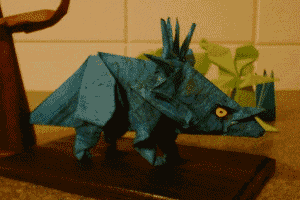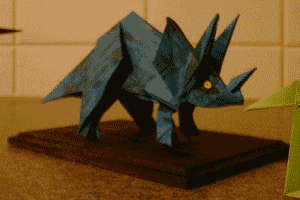Marginocephalia
Marginocephalia includes two groups, Ceratopsia and Pachycephalosauria. Ceratopsia includes all of the horned plant-eating dinosaurs. They were widespread throughout North America and Asia during the Cretaceous era. Two main groups were present, the short-filled ceratopsids and the long-frilled ceratopsids. Most ceratopsian had a curved bony beak at the front of the upper jaw which allowed them to snip off bunches of tough leaves. The Pachycephalosauria were a group of two-legged thick-skulled herbivores that existed during the Cretaceous era.
StyracosaurusStyracosaurussty-RAK-oh-SAW-rus (spiked reptile) Dr L.M. Lambe (1913) North America Cretaceous 5.5m |

|
| Styracosuarus is a well-known long-frilled ceratopsid. Most ceratopsids have small knobbly lumps around the edges of their frill. In sytracosaurus, these are fully developed. In this dinosaur, they were probably to warn off predators. They may not have been very effective as a shield as some parts of the frill were not solid bone. |
Difficulty **** |
Triceratopstry-SER-a-TOPS(Three horned face) Dr O.C. Marsh (1889) North America Cretaceous 9m |
 |
| Triceratops was one of the largest Ceratopsids. It had three large horns, one emerging from its nose and two from above its eyes. It had a short frill which was surrounded by knobs of bone. The function of the frill is not fully known. It may have been used to signal to other dinosaurs. Triceratops had a large boney beak and grinding teeth to consume its herbivorous diet. |
Difficulty **** |